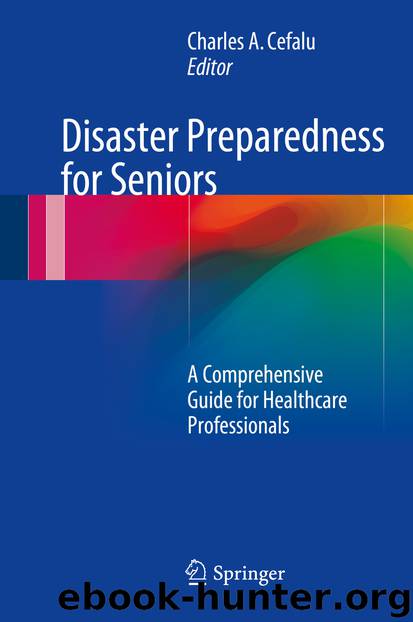Disaster Preparedness for Seniors by Charles A. Cefalu

Author:Charles A. Cefalu
Language: eng
Format: epub
Publisher: Springer New York, New York, NY
Future Directions for GEPR Training and Evaluation Programs
Core competencies: The Public Health Preparedness Core Competency Model (PHP/CCM) Version 1 [25] was released on December 2010 that fulfilled a requirement in the 2006 Pandemic and All-Hazards Preparedness Act [7] to develop “a competency-based training program to train public health practitioners” (http://www.asph.org/document.cfm?page=1081) who are mid-level public health workers. The competency model is intended to be the national standard of knowledge, behavior, and skills for the workforce to prepare for and respond to “all-hazards” events, i.e., natural disasters, health emergencies, epidemics, environmental threats, food and agriculture events, acts of terrorism, and major crisis induced by chemical, biological, radiological, nuclear, and/or explosives (CBRNE). It is the product of a cooperative agreement initiated by the Centers for Disease Control and Prevention, Office of Public Health Preparedness and Response (CDC/OPHR) with the Association of Schools of Public Health (ASPH) (http://www.asph.org/document.cfm?page=100). Although the primary focus is on mid-level public health workers, the competency model could be adapted for mid-level workers in various types of service systems so that the organization’s leadership is able to use all levels of human resources when an “all-hands-on-deck” emergency occurs. The goal is for the worker to “proficiently perform assigned prevention, response, and recovery role(s) in accordance with established national, state, and local health security and public health policies, laws and systems” [25]. The competencies are drawn from three sources: fundamental public health competencies, generic health security or emergency core competencies, and position/occupation-specific or professional competencies. In addition, competencies in these four domains—model leadership, communicate and manage information, plan for and improve practice, and protect worker health and safety are essential to build and sustain the worker’s capacity to act on his/her responsibilities.Core competencies in geriatric emergency preparedness still need to be fully articulated to identify key issues, set standards, and provide measures upon which curriculum, training, and practice can be evaluated [26] The collective expertise of the GEPR Collaborative would facilitate an examination of the applicability and usefulness of the PHP/CCM for training and evaluating performance of thousands of healthcare workers who would be called upon in a crisis to support response and recovery efforts in their organization, including many who serve diverse ethnic older populations.The CDC/ASPH report on the KSAs [27] shows a timely alignment with the PHPR/CCM. The KSAs are identified behaviors relating to mastery of the core competencies for public health preparedness personnel that can be observed and measured. Expert panels were convened that generated 172 KSAs and the KSAs are classified using Bloom’s original taxonomy for learning objectives, with some modification [28]. The modified classification has three categories: “remembering,” “doing,” and “feeling” [27] that corresponds to Knowledge or cognitive domain, Skills or psychomotor domain, and Attitudes or affective domain. The classification enables a learner to perform observable and measurable competency behaviors of proficiency that are required for public health preparedness staff to be ready and confident in response to an “all-hazards” event. The trainee may start as a novice and progress to the point of the required ability for a specific role or position.
Download
This site does not store any files on its server. We only index and link to content provided by other sites. Please contact the content providers to delete copyright contents if any and email us, we'll remove relevant links or contents immediately.
Periodization Training for Sports by Tudor Bompa(8170)
Why We Sleep: Unlocking the Power of Sleep and Dreams by Matthew Walker(6618)
Paper Towns by Green John(5091)
The Immortal Life of Henrietta Lacks by Rebecca Skloot(4526)
The Sports Rules Book by Human Kinetics(4294)
Dynamic Alignment Through Imagery by Eric Franklin(4118)
ACSM's Complete Guide to Fitness & Health by ACSM(3989)
Kaplan MCAT Organic Chemistry Review: Created for MCAT 2015 (Kaplan Test Prep) by Kaplan(3940)
Introduction to Kinesiology by Shirl J. Hoffman(3726)
Livewired by David Eagleman(3684)
The Death of the Heart by Elizabeth Bowen(3552)
The River of Consciousness by Oliver Sacks(3541)
Alchemy and Alchemists by C. J. S. Thompson(3451)
Bad Pharma by Ben Goldacre(3357)
Descartes' Error by Antonio Damasio(3230)
The Emperor of All Maladies: A Biography of Cancer by Siddhartha Mukherjee(3068)
The Gene: An Intimate History by Siddhartha Mukherjee(3047)
The Fate of Rome: Climate, Disease, and the End of an Empire (The Princeton History of the Ancient World) by Kyle Harper(3003)
Kaplan MCAT Behavioral Sciences Review: Created for MCAT 2015 (Kaplan Test Prep) by Kaplan(2940)
